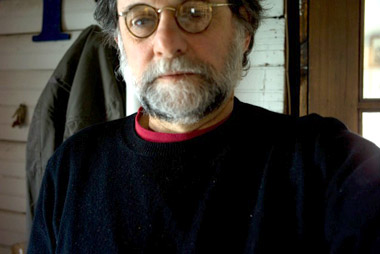In Tom Young’s photos, the world becomes a place of multiple perspectives, of layers and decay. Look closely, and it becomes clear that many images are straightforward, basically unmanipulated depctions of reality. What looks at first like a painterly treatment of a background might be weathered concrete, and what looks like staining or burning might be simply splotching on an old window.
It’s often true that connecting with and understanding works of art requires learning an intuitive kind of language. It happens easily—all the layering and cropping that Young uses to shepherd a useful ambiguity into his frames makes a viewer second-guess what an image appears to be. That kind of questioning leads, in the case of Young’s new book Timeline: Learning to See with My Eyes Closed, to a visual narrative. The images tend to work in a similar way—a large image bumps up against some smaller ones, and the group becomes a new whole. Sometimes making out the details of one of the images brings the others into clearer focus. In one, what looks at first like an indeterminate pattern of shadow and light becomes the outline of a woman. When things like that happen, the images take on new resonance with each other. Meaning and an intuitive kind of story emerge.
In Young’s case, some difficult realities are keys to what he’s conveying: he fought leukemia some years ago, and a family member’s cancer is also part of the narrative his book weaves. Much of that is present here—sometimes, he explains, because it was in a family photo album.
Though this is an almost entirely visual work, “narrative” really is the correct word to describe it. It is an emotional story, a dreamlike accruing of images that’s more tantalizing than certain. The effect is almost calming, despite blurs and tightly cropped images that clearly reference sickness and distress. The static nature of the images offers resistance to the usual habit of being swept headlong into a film or novel, and the muted colors evoke the past even in images of recent vintage.
The inspiration for this unusual approach came, Young explains, from a decidedly non-visual event. When he was 10, a medical prodecure required that his eyes be bandaged for weeks. In his artist statement, Young says, “Without sight my other senses changed greatly, and the darkness became somewhat familiar and at the same time fearful. … Saltine crackers were the only things I wanted to eat because their distinctive taste clearly matched my memory of them. Everything else tasted different, suspect. I liked to lie in the grass with my face burrowed into the earth. The quiet assumed a different nuance, both hollow and sumptuous…
“The photographs I have been making for the past 30 years are in part informed by a remembrance of that experience. The places I’m attracted to engage my senses in ways similar to those of the 10-year-old boy in bandages. I go out into the world to places where I sense something of meaning has once occurred and lingers. While photographing, I feel out of time, blinded from my everyday life. I’m looking both out into the world and back into self, where the world in front of me appears both familiar and mysterious.”
*
In Timeline, the images speak to the passing of time and the complications of lives derailed by sickness. Bodies embrace; buildings fall apart or disappear into the forest. Young did not, he says, necessarily intend to craft a specific sequence of events. Instead, his intuition led. “I work on these images without knowing exactly where I’m going. Things reveal a relationship, whether it’s visual or psychological.”
Young enjoys finding how his images can work together: “The images have a conversation with themselves that’s not linear,” he says. “Their strength and weakness is their complexity.”
Weakness is not, however, readily apparent. Purely visual storytelling is arguably less exact in what it can convey of emotion, burdened as we all are with a private stock of associations and connotations tied to images. Young recognizes that difficulty, and says he hopes people can, at least, take from his work a narrative “that hopefully relates to my own.”
Maybe it’s the air of archetype that Young’s imagery exudes, but his work taps into something primal. His primary subjects, body parts and decaying buildings, seem like near-universal pieces of visual grammar. When those subjects combine with more personal associations, something—a feeling, a half-forgotten scrap of dream—takes shape. It does take time, but the lack of time limit is a built-in advantage with still images. Young points out photographer Jerome Liebling’s take on time and photos. “Liebling said there are some images we can read instantly. But with others, wouldn’t it be funny if museums posted signs saying ‘This is 20-minute photo,’ or ‘This is a five-minute photo’?”
That kind of thinking about art makes sense when you find out more about Young. He is a retired Greenfield Community College teacher, a job he began in the 1970s, and has also taught at Amherst College. Not only has he long swum in academic waters, his work graces some prestigious walls nationwide. Closer to home, you’ll find his photos in museums at Smith College, Mount Holyoke, Amherst College, Harvard, Yale, Turners Falls’ Hallmark Museum, and Boston’s and Springfield’s Museums of Fine Arts. He’s also won a long list of awards.
The sophistication of his photography and the personal nature of his work combine to great effect. When you spend some time with Young’s book, the takeaway is a feeling of unhinging from time, a simultaneous awareness of past and present, like nostalgia and mindfulness all at once. It’s not clear exactly where that comes from, but, at least for Young, the source seems plain. “Once you’ve had a life-threatening illness, it’s with you,” he says. “It’s in how you see everything, the world, even the clouds.”•



